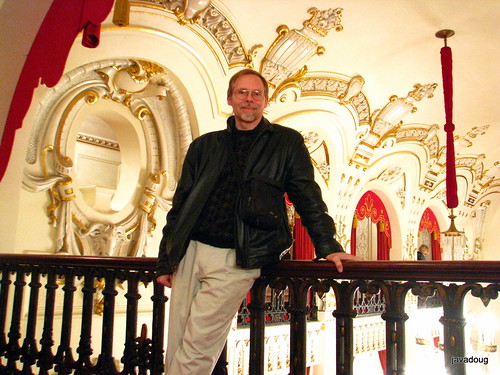Leonard Slatkin at PSO - New music and what he would conduct - Heinz Hall with Mason Bates and Richard Danielpour post concert chat
Leonard Slatkin at PSO - Mason Bates and Richard Danielpour post concert chat - Discuss their compositions Liquid Interface and Pastime - Heinz Hall - Gershwin American in Paris - Bernstein On the ...
Saturday, February 20, 2010
Photos - Slatkin, Bates and Danielpour at Heinz Hall
I read in a review by the New York Times that the PSO's program seems to some how be lacking in new music.... Well I'm not sure their definition, but judging by the evening's performance, there were two new pieces, one by Danielpour who we've seen several times this season, and an amazing Techno fusion with the orchestra and the composer Mason Bates playing 'Electronica' which could hardly be called anything but new music, something very close to popular culture, yet not lacking in interesting symphonic elements.
I was very pleased with the new music. There were quite an array of instruments here this evening (see some below). There was this large drum which I suppose made a storm like sound for the 'Liquid Interface' composition, and there was a washboard, played very interestingly, and there were even multiple glasses filled with water - the musician played it by running his wet finger along the edge!
There was also Bernstein's On the Town, and finally, Gershwin's An American in Paris, how could I go wrong?
It was nice to see Leonard Slatkin return and I'm glad he is as energetic as ever.
Leonard Slatkin at PSO - does only music that 'touches me', as in 'the music of this country'
Mason Bates and Richard Danielpour post concert chat - Discuss their compositions Liquid Interface and Pastime

I was very pleased with the new music. There were quite an array of instruments here this evening (see some below). There was this large drum which I suppose made a storm like sound for the 'Liquid Interface' composition, and there was a washboard, played very interestingly, and there were even multiple glasses filled with water - the musician played it by running his wet finger along the edge!
There was also Bernstein's On the Town, and finally, Gershwin's An American in Paris, how could I go wrong?
It was nice to see Leonard Slatkin return and I'm glad he is as energetic as ever.
Leonard Slatkin at PSO - does only music that 'touches me', as in 'the music of this country'
Mason Bates and Richard Danielpour post concert chat - Discuss their compositions Liquid Interface and Pastime

Creator: Paul McAvinney
Finger tracking and gesture interpretation software
Paul McAvinney and Dr. Joe Newcomer
Produced by the Sensor Frame Corp, Pittsburgh 1991
Presented for the PSO by Joe Newcomer
The moon, before the concert :)
Monday, February 1, 2010
Love at first sight
Mahler Symphony number 4:
The first movement begins with sleigh bells, piccolos and other woodwinds followed immediately by what I perceive as a pastoral setting conjured with the string section, which continues throughout the whole symphony.
I continue to perceive my picturesque study, framed by the oboes, piccolo and flute. Gradually I begin to think of Mahler as being a landscape painter who, with his composer's brush, paints broad strokes filling the canvas hall with harmony later to be augmented with crisp shapes which take melodic form.
Then a sudden change of tempo, as if on a journey, a tour of the snow covered fields, perhaps then to a villiage, and then people going too and fro, as the sleigh approaches it's destination - home.
2nd movement:Scherzo
With the flute I hear - a walk - a journey. Every instrument is used well, they are staggered into the music, reminiscent of the way Ravel wrote his Bolero, yet not like that music, really. I hear a subtle playing, against the dramatic theme.The oboe at the ending is very surprising, pleasantly.
3rd movement: Slow
Another surprise appears, smiling. Slow strings - Cello and violas - then joins the violins - oboes follow and the English horn. Eventually I hear the bassoon, with a beautiful low sound. At length I perceive the harp, playing a selection which at first made me think a piano was on stage, yet it was the harp.
Maestro Honeck raises the ante for a moment, lifting his baton, and the orchestra grows with restrained volume, then continues forward and back to the pastoral sound. The vibrancy continues, then changes again, with melodic pizzicato, with the base, and eventually I hear and see the drums. Again I visualize the composition being painted by Mahler before my eyes and ears, again I perceive each brush stroke being applied to this canvas, never rushing, yet always building, perhaps towards the final movement.
4th movement:
A reprise of the opening movement with melody heard before, and again it joins into another pastoral scene. Soon I hear a melody that reminds me of the music from Alfred Hitchcock's Vertigo. Often in classical music we hear that music is based on the theme of another composer's work, and I wonder if composer Bernard Herrmann has used these few notes as an inspiration for his composition on that film. Perhaps I'm wrong.
I visualize in my mind's eye waves splashing, crashing over rocks, I hear the harp, I'm seeing the very essence of this music. I'm completely into this music and its portrayal, and the way that Manfred Honeck is conducting and the beauty that is coming from the PSO directly to my ears.
I visualize in my mind's eye waves splashing, crashing over rocks, I hear the harp, I'm seeing the very essence of this music. I'm completely into this music and its portrayal, and the way that Manfred Honeck is conducting and the beauty that is coming from the PSO directly to my ears.

Subscribe to:
Posts (Atom)










